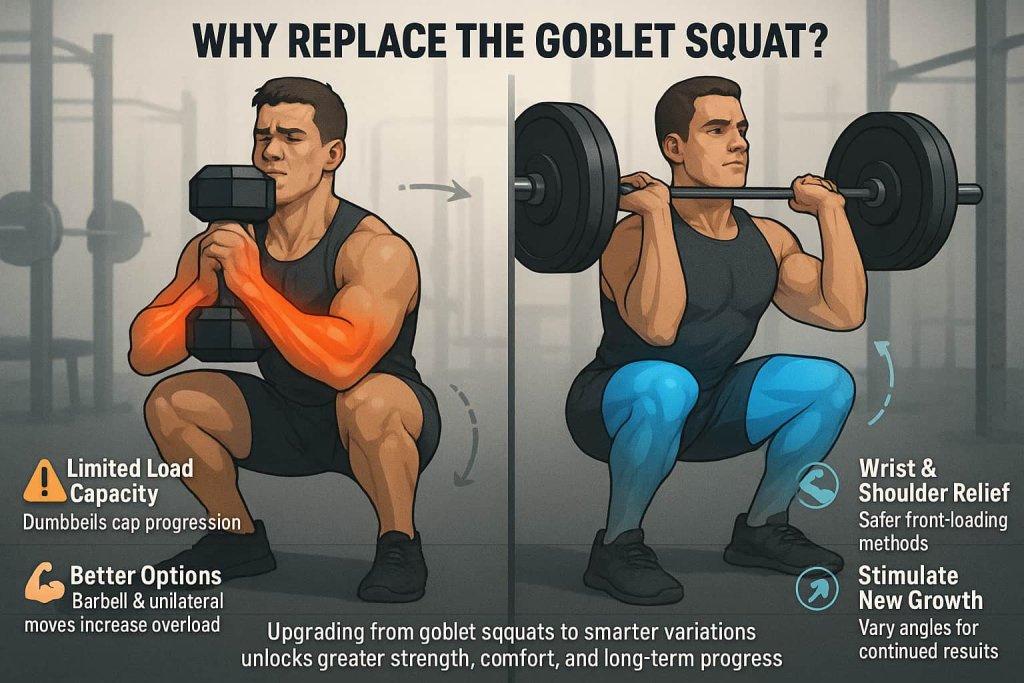The best alternatives to the goblet squat include movements like the front squat, landmine squat, split squat, and leg press — all of which target the quads, glutes, and core just as effectively, often with greater load potential.
The goblet squat is a fantastic beginner move for teaching squat mechanics and building lower-body strength. But once the dumbbell becomes too light or awkward to hold, it’s time to progress to new variations.

Understanding these alternatives helps you keep building size, power, and balance without sacrificing form or safety.
Below, we’ll cover the 10 best goblet squat alternatives, explain why each one works, and how to perform them correctly for maximum results.
Why Replace the Goblet Squat?
While the goblet squat is perfect for beginners, it can become limiting as you get stronger.
Common reasons to look for alternatives include:

- Limited Load Capacity: Most dumbbells become too light for advanced lifters.
- Grip Fatigue: Holding a heavy dumbbell at chest height strains the forearms.
- Mobility Limitations: Front loading may cause wrist or shoulder discomfort.
- Variety and Progression: Using new angles and tools helps stimulate new muscle growth.
According to the Experts, switching to barbell or unilateral variations helps maintain progressive overload while improving balance and movement control.
10 Best Goblet Squat Alternatives
These movements mimic the goblet squat’s muscle activation while offering greater load potential, balance, and versatility. Each alternative helps you build stronger legs, improve stability, and continue progressing safely.
1. Front Squat
Why it works:
The front squat closely replicates the goblet squat’s upright torso angle but allows heavier loads for greater strength gains. It shifts the center of gravity forward, increasing quad and core activation while reducing spinal compression compared to the back squat.
Muscles worked:
Quadriceps, glutes, core, upper back, erector spinae.
How to do it:
- Set a barbell on a rack at shoulder height.
- Step under and rest it across your front shoulders, keeping elbows lifted.
- Brace your core, descend into a controlled squat until thighs are parallel.
- Drive through your heels and return to standing while maintaining posture.
Trainer Tip:
Keep your elbows high throughout — dropping them shifts the bar forward and strains the wrists and back.
2. Landmine Squat
Why it works:
The landmine squat maintains a front-loaded position but the bar path’s arc reduces stress on the spine and shoulders. It’s one of the safest progressions for those transitioning from goblet squats to barbell squats.
Muscles worked:
Quads, glutes, hamstrings, core.
How to do it:
- Anchor one end of a barbell into a landmine base or corner.
- Hold the free end close to your chest with both hands.
- Stand tall, feet shoulder-width apart, and lower into a deep squat.
- Keep your torso upright as you push back to standing.
Trainer Tip:
Lean slightly into the bar for balance. The angled resistance makes it excellent for anyone with lower-back or knee sensitivity.
3. Dumbbell Front Squat
Why it works:
A perfect middle ground between goblet and barbell squats, the dumbbell front squat allows heavier resistance while maintaining joint-friendly loading. It also increases stabilizer activation due to independent arm positioning.
Muscles worked:
Quadriceps, glutes, core, shoulders.
How to do it:
- Hold a dumbbell in each hand at shoulder height, palms facing each other.
- Engage your core and descend into a full squat.
- Keep chest tall and elbows high throughout the movement.
- Drive through your heels to rise back up.
Trainer Tip:
Avoid resting the dumbbells directly on your shoulders — keep them slightly forward to maintain tension and stability.
4. Bulgarian Split Squat
Why it works:
This unilateral powerhouse increases balance, stability, and single-leg strength. It mimics goblet mechanics but emphasizes glute and quad activation independently.
Muscles worked:
Quads, glutes, hamstrings, core stabilizers.
How to do it:
- Stand about two feet in front of a bench.
- Place your back foot on the bench, laces down.
- Lower until your front thigh is parallel to the floor.
- Push through the front heel to return to standing.
Trainer Tip:
Lean your torso slightly forward to shift focus to the glutes; keep movement slow and controlled for balance.
5. Step-Up
Why it works:
Step-ups are a functional unilateral exercise that strengthens the same muscle groups as goblet squats while improving balance, hip stability, and coordination.
Muscles worked:
Quadriceps, glutes, hamstrings, calves.
How to do it:
- Stand facing a sturdy bench or box.
- Step onto it with one leg, pressing through your heel.
- Fully extend your hips at the top, then lower slowly.
- Alternate sides for even development.
Trainer Tip:
Avoid pushing off the trailing leg. Keep all the drive through your front heel to isolate the working leg.
6. Barbell Back Squat
Why it works:
The barbell back squat is a major upgrade once you master goblet mechanics. It allows the greatest load for overall leg growth and strengthens the posterior chain for athletic power.
Muscles worked:
Quadriceps, glutes, hamstrings, spinal erectors, core.
How to do it:
- Rest a barbell across your upper traps (not your neck).
- Grip the bar firmly and engage your core.
- Descend until thighs are parallel or slightly below parallel.
- Push through heels to return to the top.
Trainer Tip:
Brace your core before each rep to prevent lumbar flexion. Focus on control over depth rather than ego-driven weight.
7. Hack Squat (Machine or Free-Weight)
Why it works:
Hack squats provide quad isolation without balance demands, making them excellent for hypertrophy. The guided path supports your back while maintaining consistent tension.
Muscles worked:
Quadriceps, glutes, calves.
How to do it:
- Step into the hack squat machine with shoulders under pads.
- Keep feet shoulder-width apart and slightly forward.
- Lower the sled until knees reach a 90° angle, then drive upward.
Trainer Tip:
Position your feet higher on the platform for glute emphasis or lower for quad dominance. Avoid locking knees at the top.
8. Sissy Squat
Why it works:
This bodyweight classic isolates the quads like no other — ideal for home training or accessory work. It challenges your anterior chain with full-range knee extension.
Muscles worked:
Quadriceps, hip flexors, core.
How to do it:
- Stand tall and grab a stable surface for support.
- Lean back as you bend your knees, keeping your body straight.
- Lower as far as comfortable, then extend your knees to return upright.
Trainer Tip:
Focus on slow, controlled movement. Beginners can use a strap or wall support until comfortable with balance.
9. Leg Press
Why it works:
A controlled, machine-based move that lets you safely overload the quads without upper-body or grip fatigue. Great for isolating lower-body muscles with reduced injury risk.
Muscles worked:
Quads, glutes, hamstrings.
How to do it:
- Sit in the leg press with your back flat against the pad.
- Place feet shoulder-width apart on the platform.
- Lower the sled until your knees are at 90°, then push up without locking out.
Trainer Tip:
Keep your lower back pressed against the pad to avoid lumbar strain. Adjust stance width to shift muscle emphasis.
10. Zercher Squat
Why it works:
The Zercher squat keeps the bar in front of the body like a goblet squat but allows much heavier loads. It improves core stability, posture, and total-body tension.
Muscles worked:
Quads, glutes, core, upper back, biceps.
How to do it:
- Hold a barbell in the crook of your elbows against your torso.
- Keep chest lifted and descend into a deep squat.
- Drive through your heels to stand, maintaining elbow height.
Trainer Tip:
Use a bar pad or towel for comfort. Engage your core to stabilize the bar throughout each rep.
How to Add These Exercises to Your Leg Day
- Beginners: Use landmine or dumbbell front squats for control.
- Intermediate: Mix unilateral moves (split squats, step-ups).
- Advanced: Rotate front, back, and Zercher squats weekly for variety and progression.
Perform 3–4 sets of 8–12 reps, depending on your strength goal.
Common Mistakes to Avoid
- Rounding your lower back under heavy load.
- Knees caving inward during descent.
- Lifting heels off the floor.
- Rushing reps — prioritize control and depth.
Safety and Form Tips for Leg Training
Stay injury-free by focusing on control and alignment, not just weight.
- Warm-Up:
5 min of light cardio + dynamic stretches for hips, quads, and hamstrings. - Form:
Keep a neutral spine, core tight, knees tracking over toes, and heels grounded. - Progress:
Add weight slowly (5–10% weekly), rest 48 hrs between leg days, and stop if pain appears. - Bottom Line:
Perfect form + gradual loading = stronger, safer legs.
FAQ
1. Can I replace goblet squats completely?
Yes. Exercises like the front squat or landmine squat replicate similar muscle activation with more progressive loading options.
2. Are goblet squat alternatives beginner-friendly?
Yes. Dumbbell front squats and step-ups are safe, easy-to-learn variations.
3. Which exercise targets the quads most like goblet squats?
Front squats and hack squats emphasize the quadriceps strongly.
4. What if I don’t have any equipment?
Use bodyweight moves like sissy squats or split squats.
5. How often should I train these alternatives?
2–3 times per week, allowing at least 48 hours between leg sessions.
6. Is the landmine squat good for bad knees?
Yes, it offers an angled load that reduces knee and back stress.
7. Which option is best for building mass?
Barbell back squats, leg presses, and front squats offer the greatest hypertrophy potential.
Conclusion
If the goblet squat no longer challenges you or causes discomfort, these alternatives will keep your leg gains progressing safely and effectively. Choose variations that fit your equipment, skill level, and comfort — and continue to prioritize form and gradual overload.
Build smarter, not just harder — your legs will thank you.
References
- Gullett JC, et al. (2009). “A biomechanical comparison of back and front squats in healthy trained individuals.” Journal of Strength & Conditioning Research.
https://pubmed.ncbi.nlm.nih.gov/19002072/ - Straub RK, et al. (2024). “A Biomechanical Review of the Squat Exercise: Implications for Clinical Practice.” International Journal of Sports Physical Therapy.
Full text (PMC): https://pmc.ncbi.nlm.nih.gov/articles/PMC10987311/ - American College of Sports Medicine (2009). “Position Stand: Progression Models in Resistance Training for Healthy Adults.” Medicine & Science in Sports & Exercise.
PubMed: https://pubmed.ncbi.nlm.nih.gov/19204579/ - Wirth K, et al. (2016). “The Impact of Back Squat and Leg-Press Exercises on Maximal Strength and Speed-Strength Parameters.” Journal of Strength & Conditioning Research.
PubMed: https://pubmed.ncbi.nlm.nih.gov/26439782/ - Martín-Fuentes I, et al. (2020). “Evaluation of the Lower Limb Muscles’ Electromyographic Activity in the Leg Press Exercise: A Systematic Review.”
Full text (PMC): https://pmc.ncbi.nlm.nih.gov/articles/PMC7369968/ - Liao K-F, et al. (2021). “Effects of unilateral vs. bilateral resistance training on strength, jump, linear and change-of-direction speed: Systematic review & meta-analysis.”
Full text (PMC): https://pmc.ncbi.nlm.nih.gov/articles/PMC9331349/ - Goršič M, et al. (2020). “Biomechanical comparisons of back and front squats with a straight bar and four squats with a transformer bar.”
Full text (PMC): https://pmc.ncbi.nlm.nih.gov/articles/PMC8106690/ - National Strength & Conditioning Association (NSCA). “Exercise Technique: High-Bar Back Squat.”
NSCA Technique Page: https://www.nsca.com/education/videos/exercise-technique-high-bar-back-squat/
